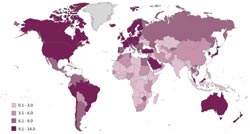Where in the World are Young People Using the Internet?

Digital natives as a percentage of total population, 2012<br>Courtesy: ITU<br>
According to a common myth, today’s young people are all glued to the Internet. But in fact, only 30 percent of the world’s youth population between the ages of 15 and 24 years old has been active online for at least five years. In South Korea, 99.6 percent of young people are active, the highest percentage in the world. The least? The Asian island of Timor Leste with less than 1 percent.
Those are among the many findings in a study from the Georgia Institute of Technology and International Telecommunication Union (ITU). The study is the first attempt to measure, by country, the world’s “digital natives.” The term is typically used to categorize young people born around the time the personal computer was introduced and have spent their lives connected with technology.
Nearly 96 percent of American millennials are digital natives. That figure is behind Japan (99.5 percent) and several European countries, including Finland, Denmark and the Netherlands.
But the percentage that Georgia Tech Associate Professor Michael Best thinks is the most important is the number of digital natives as compared to a country’s total population.
“That’s because a country’s future will be defined by today’s young people and by technology,” said Best, who co-led the study and, jointly with ITU, developed the model that calculated the worldwide figures. “Countries with a high proportion of young people who are already online are positioned to define and lead the digital age of tomorrow.”
The countries with the highest proportion of digital natives among their population are mostly rich nations, which have high levels of overall Internet penetration. Iceland is at the top of the list with 13.9 percent. The United States is sixth (13.1 percent). A big surprise is Malaysia, a middle-income country with one of the highest proportions of digital natives (ranked 4th at 13.4 percent). Malaysia has a strong history of investing in educational technology.
The countries with the smallest estimated proportion of digital natives are Timor-Leste, Myanmar and Sierra Leone. The bottom 10 consists entirely of African or Asian nations, many of which are suffering from conflict and/or have very low Internet availability.
However, the report notes that Internet usage has increased significantly in the developing world during the past five years. The ITU believes the digital native population in these regions will more than double by 2017.
Overall, there are approximately 363 million digital natives out of a world population of nearly 7 billion (5.2 percent).
“Youth are transforming our world through the power of information and communication technologies,” said Hamadoun Touré, ITU secretary-general. “The Youth Declaration developed at ITU’s BYND2015 Youth Summit in Costa Rica and presented to the UN General Assembly last week by Costa Rican President Laura Chinchilla calls for more measurable targets to monitor the digital empowerment of young people at national, regional and international levels. This first attempt to measure the number of digital natives around the world is a valuable first contribution to this effort.”
The model was developed using data collected by the ITU through surveys conducted around the globe. The study is part of the ITU’s Measuring the Information Society 2013 report, which was released on October 7.
Best is a faculty member in the College of Computing and Ivan Allen College of Liberal Arts. His research focuses on information and communication technologies for social, economic and political development, primarily in low-income countries in Africa and Asia.
Media Contact
All latest news from the category: Studies and Analyses
innovations-report maintains a wealth of in-depth studies and analyses from a variety of subject areas including business and finance, medicine and pharmacology, ecology and the environment, energy, communications and media, transportation, work, family and leisure.
Newest articles

High-energy-density aqueous battery based on halogen multi-electron transfer
Traditional non-aqueous lithium-ion batteries have a high energy density, but their safety is compromised due to the flammable organic electrolytes they utilize. Aqueous batteries use water as the solvent for…

First-ever combined heart pump and pig kidney transplant
…gives new hope to patient with terminal illness. Surgeons at NYU Langone Health performed the first-ever combined mechanical heart pump and gene-edited pig kidney transplant surgery in a 54-year-old woman…

Biophysics: Testing how well biomarkers work
LMU researchers have developed a method to determine how reliably target proteins can be labeled using super-resolution fluorescence microscopy. Modern microscopy techniques make it possible to examine the inner workings…





















